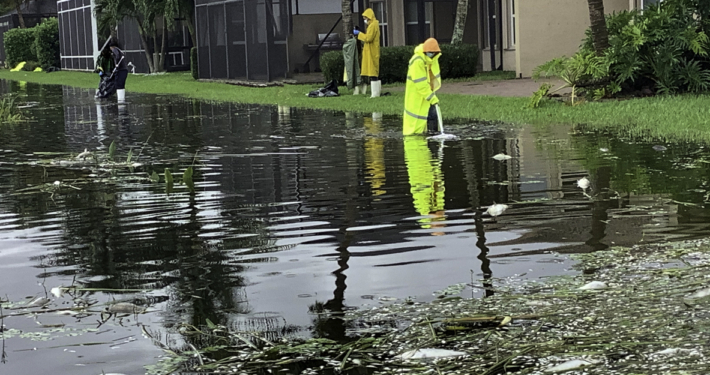Mosquitoes After Hurricanes: A Hidden Threat for Outdoor Workers and Safety Managers
By: Richard Rich
When hurricanes strike, they leave behind more than just wind damage and flooding. One often-overlooked hazard is the surge in mosquito populations, which can create a significant health risk for outdoor workers. For safety managers overseeing post-storm cleanup and recovery efforts, understanding the connection between hurricanes, stagnant water, and mosquito activity is essential to ensuring worker safety. Let’s explore how hurricanes impact mosquito populations and what steps can be taken to mitigate the risks.
How Hurricanes Create Ideal Conditions for Mosquitoes
Hurricanes and other extreme weather events can drastically increase mosquito populations due to the abundance of stagnant water left behind by floods. Floodwater provides the perfect breeding ground for mosquitoes, especially in humid, storm-prone regions like Florida. According to Newsweek, Imelda Moise, a geography professor at the University of Miami, explains that “hurricanes can lead to an explosion in mosquito numbers due to the creation of ideal breeding conditions from increased rainfall, elevated humidity, and nutrient-rich floodwaters.”
In a study of Hurricane Irma, Moise found that mosquito populations in Miami-Dade County spiked up to 8 times higher in the four weeks following the hurricane compared to non-hurricane periods. This sudden increase heightens the risk of mosquito-borne diseases such as dengue, Zika, malaria, and West Nile virus. For outdoor workers who spend extended hours in these areas, the risk of being bitten—and contracting a disease—becomes much greater.
The Role of Floodwater Mosquitoes and Disease Vectors
Floodwater mosquitoes become highly active after hurricanes, as stagnant water left by floods creates ideal breeding conditions. These mosquitoes can lay dormant eggs that hatch en masse after flooding, leading to a significant surge in their population. While these mosquitoes are aggressive biters and a nuisance, other mosquito species that thrive in these same conditions, such as Aedes aegypti, pose a much greater public health threat.
In the aftermath of hurricanes, mosquito-borne diseases like dengue, Zika, and chikungunya become serious concerns. This was notably seen after Hurricane Maria in Puerto Rico, where dengue cases spiked due to the rapid spread of Aedes mosquitoes. The risk of vector-borne diseases is particularly high after hurricanes because the increased mosquito population coincides with disrupted healthcare services, making it harder to control outbreaks and treat infected individuals.
These disease vectors can quickly become a public health crisis, putting outdoor workers and communities at risk. The rapid development of mosquitoes after hurricanes means that within just days of a flood event, the likelihood of mosquito-borne disease transmission increases sharply, requiring urgent action to control mosquito populations and protect vulnerable people.
Why Mosquito Populations Can Persist
The health risks associated with mosquitoes do not disappear once floodwaters recede. In fact, standing water can remain for weeks, providing ongoing breeding grounds for mosquitoes. Newsweek highlighted that the lingering floodwaters create “a subsequent increase in mosquito populations,” which can last for an extended period, especially if the water doesn’t recede quickly. This makes it crucial for safety managers to remain vigilant even weeks after a storm.
Additionally, population displacement due to floods can bring people into closer proximity to mosquito-heavy areas, increasing the risk of mosquito-borne diseases. For safety managers responsible for outdoor crews, being aware of the long-term nature of these risks is critical to planning appropriate protective measures.
Prevention and Protection for Outdoor Workers
To minimize the risk of mosquito bites and mosquito-borne diseases after a hurricane, safety managers should implement the following preventive strategies:
- Eliminate Standing Water: Workers should regularly inspect their work areas for any standing water, such as in buckets, construction zones, or low-lying areas. Removing this water will help reduce mosquito breeding opportunities.
- Use EPA-Approved Insect Repellents: Encourage workers to use effective insect repellents, particularly those with active ingredients like IR3535, DEET, or Picaridin, which have been proven to deter mosquitoes.
- Wear Protective Clothing: Outdoor workers should wear long-sleeved shirts, long pants, and hats to limit skin exposure to mosquitoes. While this may be uncomfortable in the heat and humidity following a storm, it’s essential for protection.
- Support Local Mosquito Control Efforts: Safety managers should coordinate with local authorities to support mosquito control efforts, such as aerial spraying or fogging, which can help reduce mosquito populations in the aftermath of a storm.
- Monitor for Symptoms of Mosquito-Borne Diseases: Workers should be educated on the symptoms of diseases like dengue and West Nile virus. If anyone experiences fever, rash, or joint pain, they should seek medical attention promptly.
- Personal Mosquito Control Solutions: Safety managers can also explore using mosquito traps or foggers in work zones to provide an additional layer of protection. Consumer-level repellents and treatments for outdoor areas can help, though their effectiveness may diminish after heavy rains.
The Role of Climate Change in Mosquito Surges
As storms grow more intense due to climate change, mosquito populations are expected to continue surging after hurricanes and flooding events. NC Health News quoted Reiskind as saying, “One thing that is becoming fairly clear with climate change is that we are seeing more intense storms.” These more frequent and severe storms create the perfect conditions for floodwater mosquitoes to thrive.
For outdoor workers, this means that mosquito-related risks could become even more pronounced in the coming years. Safety managers will need to take a proactive approach to prevent mosquito bites and reduce the risk of disease, especially as storms become stronger and more unpredictable.
Conclusion
For outdoor workers and safety managers, hurricanes bring more than just the immediate threat of wind and flooding. The surge in mosquito populations after a storm can pose serious health risks, from nuisance bites to potentially deadly diseases. By eliminating standing water, using proper repellents, and supporting mosquito control efforts, outdoor workers can stay safe and protected in the weeks following a storm.
As climate change intensifies, proactive mosquito control will become even more essential for safeguarding outdoor workers’ health. Understanding the relationship between hurricanes and mosquito populations is the first step in ensuring a safe work environment during the storm recovery process.
By staying informed and taking preventive measures, outdoor workers and their supervisors can better protect themselves from the hidden hazards that mosquitoes bring in the wake of hurricanes.







